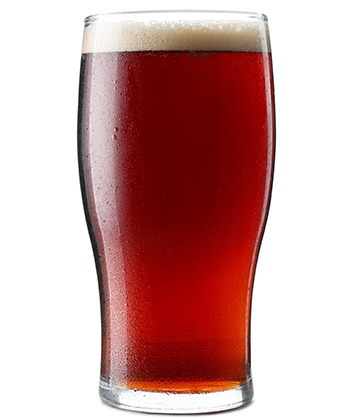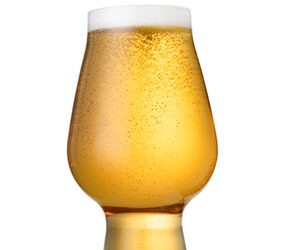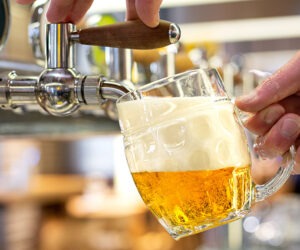British Strong Bitter

Strong bitter may not be the most familiar member of the British bitter family, but you likely know it by its other names: ESB (Extra Special Bitter) and English pale ale. These higher alcohol, more bitter ales have long been exported to the U.S. and elsewhere, so they tended to become more well known and popular. Fuller’s ESB is a unique product within the English market, but it served to create a craft beer style in the U.S., at least before IPAs became dominant.
Strong bitter is the strongest member of the bitter family of cask ales in the U.K., being greater than 4.5% ABV – still on the lower end of a standard-strength beer in the U.S. Many say English pale ale is simply the bottled version of a bitter, although that does somewhat ignore history as pale ales were created first. English pale ales were the inspiration for the American pale ale style, which clearly led to additional styles. In the early craft beer days in the U.S., it was quite common for brewpubs to have an ESB on tap — a malty, bitter ale with English malt, hop, and yeast flavors. The strong cask bitters in the U.K., the ESBs in the U.S., and the exported English pale ales all basically are described by the strong bitter style.
The Beer Judge Certification Program (BJCP) prefers not to use ESB as a style name since it refers to a specific trademarked English product, and nobody in the U.K. thinks of it as a style. English pale ale is a better name, although bitter is the name associated with this type of draft or cask beer in its country of origin. Since most American drinkers think ESB means Extra Special Bitter as a generic name, maybe that is what is happening after all. Just understand that it will cause Brits to cringe if they hear ESB used this way. My personal reason to not use ESB as a style name is that it makes judges think of Fuller’s ESB, and rarely do other bitters approach that profile.
Strong Bitter is style 11C in the BJCP Style Guidelines, in Category 11: British Bitter. It shares the category with 11A Ordinary Bitter and 11B Best Bitter. The British Bitter category does share a common history and general profile, with the beers primarily being differentiated by alcohol strength.
History
Bitters in Great Britain are mostly a 20th century phenomenon, but they do trace back to earlier pale ales. Pale malt was invented in the 1600s, so pale beer was not really possible to make before then. Even so, it remained relatively expensive for the next century or two. Pale ale and pale beer existed in the 1700s but it really wasn’t like products today. Modern pale ale traces back to the highly hopped beers later known as IPAs sent to India from London starting in the late 1700s.
This export pale ale didn’t become available in England until the 1830s, by which time it was being made more in Burton than in London. Railroads in the 1840s and 1850s helped it gain more local markets, and by the 1860s most breweries offered at least one. Before the 1900s, these tended to be higher in alcohol, aged, or keeping beers. Lower gravity unaged (also known as mild or running) pale ales called light bitters or light ales were developed in the late 1800s and are probably the most direct ancestors of modern bitters.
World War I caused gravities to drop in all beer styles, and the resulting compression of gravity ranges caused breweries to drop products that no longer were sufficiently differentiated. The lower gravity bitters became increasingly popular, and finally became the most sold style after World War II. Pale ales still existed but were positioned as a bottled, premium product, often for export, which is its current form.
Most authoritative writers on English beer (Michael Jackson, Martyn Cornell, Roger Protz, Ron Pattinson) agree that pale ale and bitter are basically synonyms. More nuanced views emerge as they discuss the products at different points in their evolution, with most agreeing that as of the second half of the 20th century, bitter was basically the draft or cask form, and that pale ale was a bottled product. Earlier usages of the term bitter (in the mid-1850s) existed, but not to describe a style as much as to literally differentiate the sweeter milds from more bitter beers.
Michael Jackson is the source of the term “strong bitter,” where he uses it to talk about the differences between them and ordinary and best bitters when breweries offered three products. Many would have only made an ordinary bitter and a best bitter, however. Naming clearly wasn’t standardized, so the separation of styles is similar to how the X system was used in the previous century. Remember that in the U.K., beer is priced based on alcohol content, so having ways of highlighting this is important to consumers.
Sensory Profile
Strong bitters are medium to medium-high bitter in the balance, but the malt backbone tempers the impact. Bitterness can rise with the alcohol level and final gravity, with some examples topping out around 50 IBUs (most are lower). The malt profile is British, with bready and biscuity flavors dominating, sometimes with light toast and caramel flavors. Americans tend to overemphasize caramel flavors, often due to their sampling of perhaps oxidized imports. Authentic bitters are generally more fruity than caramelly, which is one reason I recommend seeking out fresh, local examples of beer styles from other countries.
The alcohol level of strong bitter is larger than 4.5%, but stops short of strong ales, generally around 6%. There can be some overlap with English IPAs in gravity, with English IPAs being the classic Burton beer with sulfury notes and a marked hop and bitterness balance. Strong bitters have more of a malt presence. The color is in the amber to copper range, sometimes getting down into deep gold but it should stop short of brown. Clarity is good, and the head is typically low but is carbonation- and service-dependent.
The yeast and hop character can give fruity notes, although the range of English hop characteristics can give floral and earthy notes in addition to fruity notes. I find apple and pear esters more from yeast, with orange and citrus coming more from hops. Stronger bitters can also be dry hopped, so having a fresh hop note. In better pubs, this can be done in the cellar by the publican. The flavor dimension of yeast and hops can exceed the aroma.
The body of the beer can be medium-light to medium-full, with stronger versions often showing more body. Carbonation is lower on draft than in bottled products, but don’t expect cask levels of carbonation in bottles. A light alcohol warmth can sometimes be noted in examples in the 6% range, but it isn’t required.
The balance should lean bitter, but malt should not be in the background. Malt, hops, and yeast character should be noticeable in the aroma, flavor, and aftertaste. The finish should be dry to medium-dry, and the beer should retain the sessionable qualities of other bitters, albeit at a respectable alcohol level.
Brewing Ingredients and Methods
Strong bitters and pale ales are made like other British bitters. The base of pale ale malt is common, with small amounts of character grains or sugars included to enhance flavor and color. Any kind of British pale ale malt can be used; don’t think that Maris Otter is a requirement, but those with bready and biscuity flavors are common. Crystal malts can be used in relatively small percentages (often under 5%) to provide additional flavors and darker colors, but so can brewing sugars. Adjuncts such as corn, rice, or wheat can be used as well.
British beers are generally infusion mashed, with some commercial versions still being parti-gyled (making multiple beers from one mash through separate boils and blends). Single infusion mashes as used commonly by American homebrewers are more than sufficient for making most British beers. Bitters are typically dry, so a conversion temperature within a few degrees of 151 °F (66 °C) is common.
While the range of hops is broader than in the past, most judges and consumers expect a British character to the hopping. Varieties like Goldings and Fuggle are traditional, but a range of English hops are available and can be used. There is more experimentation now with modern or American-type hops, but for competition I try to stick with traditional English varieties.
Most hops are added as a bittering addition when brewing strong bitters. This style does not typically have a huge late-hop aroma and flavor, so traditional flavor and aroma hopping techniques can be used. Dry hopping is relatively rare, but can be done (often by adding hop plugs to a cask). This isn’t to say that American craft brewers haven’t been adding more hops near the end of the boil or as dry hop additions, but understand that is not traditional.
Versions meant to evoke Burton-on-Trent can have a more drying, sulfate character, with the water being treated with calcium sulfate, but not all versions of bitter need have a Burton water character. I tend to think this character is better suited to English IPAs, particularly in competition. Using water with more calcium chloride gives a rounder impression, which can enhance the malt flavors.
British yeast strains are often associated with certain breweries, which can influence your choice. I’m fond of the fruity Fuller’s strain (Wyeast 1968 or White Labs WLP002) as my main English yeast, but I also like Wyeast 1335 (British Ale II) as a balanced yeast. Wyeast 1318 (London Ale III) tends to make a malty beer, while Wyeast 1469 (West Yorkshire Ale) seems minerally to me. Wyeast 1028 (London Ale) can be a bit sulfury but does a great job attenuating. Any of these, or their equivalents from other yeast manufacturers, can work with this style very well.
Homebrew Example
This is a fun recipe with some unusual techniques, so please read carefully. If you are using recipe software, set your mash efficiency to 48% because we are using a no-sparge technique. This involves using a thin mash, running off the entire mash without sparging, then topping off the beer with strike water in the kettle to hit the initial volume. It is best to prepare all brewing liquor with acid and salts rather than just the mash. The flavor quality of the malt will be superior, and is akin to using first runnings from a large brew. However, some grain will be sacrificed in this method; hence, the lower efficiency.
I am using classic English ingredients in the recipe, with the exception of Victory® malt, which is a U.S. malt from Briess designed to enhance the biscuity/toasty English flavor profile that many judges prefer (myself included). My personal preference of maltsters for the base malt and crystal malt is Crisp. I’m using the Fuller’s yeast strain, which gives a nice fruitiness, and is very easy to clear in a cask. Classic English hops are used, with the addition of some late Styrian Golding, a personal favorite.
This was a recipe I originally put together for serving a cask ale at the old Real Ale Festival, where it was served on a hand pump from a pin cask. I was happy to see the beer pour bright after a single glass, once it had been set up in its serving location the night before and stored cold. It was crushed the next day with help of a small gaggle of Englishman who spent the entire festival next to the cask. That’s the kind of validation that works for me.
Strong Bitter by the Numbers:
OG: 1.048–1.060
FG: 1.010–1.016
SRM: 8–18
IBU: 30–50
ABV: 4.6–6.2%
Strong Bitter
(5 gallons/19 L, all-grain)
OG = 1.053 FG = 1.013
IBU = 39 SRM = 13 ABV = 5.2%
Ingredients
13 lbs. (5.9 kg) Maris Otter malt
12 oz. (340 g) Crystal malt (70–80 °L)
8 oz. (227 g) flaked maize
5.3 oz. (150 g) Briess Victory® malt
1 oz. (28 g) black patent malt
4.5 AAU Styrian Golding hops (first wort hop) (1 oz./28 g at 4.5% alpha acids)
4.1 AAU Challenger hops (60 min) (0.5 oz./14 g at 8.3% alpha acids)
4.5 AAU Fuggle hops (20 min.) (4.5% alpha acids)
1 oz. (28 g) Styrian Golding hops (0 min.)
1 oz. (28 g) Styrian Golding hops (whirlpool)
Wyeast 1968 (London ESB), White Labs WLP002 (English Ale), Imperial Yeast A09 (Pub), or LalBrew London ESB yeast
3⁄4 cup corn sugar (if priming)
Step by Step
This recipe uses reverse osmosis (RO) water. Adjust all brewing water to a pH of 5.5 using phosphoric acid. Add 1 tsp. calcium sulfate and 1⁄4 tsp. calcium chloride to the mash.
This recipe uses a single infusion mash, with a no-sparge lauter. Use enough water to have a moderately thin mash (2 qts./lb). Mash in the Maris Otter malt and flaked maize at 152 °F (67 °C) and hold for 60 minutes. Add remaining grains, then raise the mash temperature with boiling water to 168 °F (76 °C) and recirculate for 20 minutes.
Drain the kettle completely without sparging. Add brewing liquor necessary to achieve 6.5 gallons (24.5 L) volume in the kettle (do not sparge, add the water directly to the kettle). Boil the wort for 90 minutes, adding hops at the times indicated in the recipe. The FWH hops go in the empty kettle before lautering.
Chill the wort to 66 °F (19 °C), pitch the yeast, and ferment until complete.
Rack the beer, prime and bottle condition, package in a cask, or keg and force carbonate.
Strong Bitter
(5 gallons/19 L, extract with grains)
OG = 1.053 FG = 1.013
IBU = 39 SRM = 13 ABV = 5.2%
Ingredients
6.5 lbs. (3 kg) Maris Otter malt extract
12 oz. (340 g) Crystal malt (70–80 °L)
5.3 oz. (150 g) Briess Victory® malt
1 oz. (28 g) black patent malt
4.5 AAU Styrian Golding hops (first wort hop) (1 oz./28 g at 4.5% alpha acids)
4.1 AAU Challenger hops (60 min) (0.5 oz./14 g at 8.3% alpha acids)
4.5 AAU Fuggle hops (20 min.) (4.5% alpha acids)
1 oz. (28 g) Styrian Golding hops (0 min.)
1 oz. (28 g) Styrian Golding hops (whirlpool)
Wyeast 1968 (London ESB), White Labs WLP002 (English Ale), Imperial Yeast A09 (Pub), or LalBrew London ESB yeast
3⁄4 cup corn sugar (if priming)
Step by Step
Use 6 gallons (23 L) of water in the brew kettle; heat to 158 °F (70 °C). Steep the crystal, Victory®, and black malts for 30 minutes, then remove.
Turn off the heat. Add the malt extracts and stir thoroughly to dissolve completely. You do not want to feel liquid extract at the bottom of the kettle when stirring with your spoon. Add the first wort hops. Turn the heat back on and bring to a boil.
Boil the wort for 60 minutes, adding remaining hops at the times indicated. When done, chill the wort to 66 °F (19 °C), pitch the yeast, then ferment until complete.
Rack the beer, prime and bottle condition, package in a cask, or keg and force carbonate.



